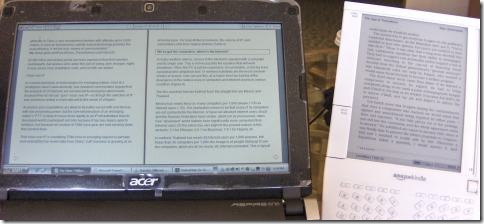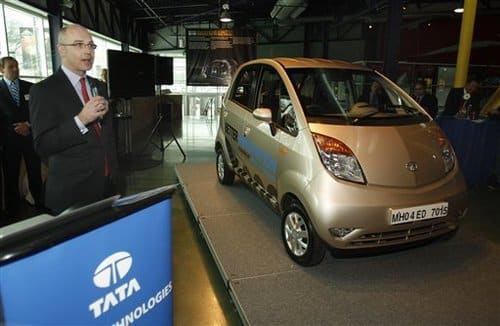Pixel Qi is there – a little at least. is there – a little at least. The innovative dual-mode technology, which the advantages of a conventional LCD display (display in darkness, brilliance ) and e -paper (high resolution, no direct lighting , low power consumption in a panel together ), can be immediately via mounting kit The innovative technology, which the advantages of a LCD display in darkness, brilliance) and e-paper (high resolution, no direct lighting, low power consumption in a panel together), can be get into their own netbook …..
I got a chance to catch up with the folks from Pixel Qi this morning. If you’re not familiar with the company, it was founded by Mary Lou Jepsen, one of the designers of the original XO Laptop. And Pixel Qi makes LCD displays that are unlike any you’ve ever seen. When you turn the backlight off, the screen is still readable in a high contrast black and white mode. They actually look like e-Ink displays, but they’re not. Turn up the backlight, and you have full color saturation.
The net effect is that you can put a Pixel Qi display in a netbook, tablet, or eBook reader and have a device that you can read indoors or outdoors. It can handle full motion video. And there’s non of that page refreshing effect that you experience with eBook readers like the Kindle and Nook.
One of the other side effects of using the Pixel Qi display is reduced power consumption. In full color mode, the LCD uses about 2.5 watts of power, which is about what you’d get from any other LCD screen. But when you cut the backlight off, that drops to about 0.5 watts.
The image above shows a standard off-the-shelf Lenovo IdeaPad S10-2 that’s been retrofitted with a Pixel Qi display. While there are no plans to sell this particular model, I was told that you can get about an extra hour of battery life by using a Pixel Qi screen in high contrast mode with the backlight off. If you were to put the same screen in a low power ARM-based smartbook or tablet that only uses 7 to 8 watts of power total, then you could see as much as a 30 to 40% increase in battery life by using a Pixel Qi display.
Also demonstrated was the same screen technology with a capacitive sensor on top of the screen, facilitating touchscreen features. This was shown on both a netbook and a tablet from AccuSee, and the touch functions are better suited for the tablet. A Wacom tablet was also outfitted with the Pixel Qi technology, which worked just as well in both modes.
There are apparently 6 different companies showing off devices with Pixel Qi screens at CES this week, but most of them are holding private meetings and Pixel Qi isn’t saying who’s got what.But the product categories range from netbooks to tablets, and possibly some other devices. If I see any actual products on the show floor, I’ll be sure to let you know.
Pixel Qi expects to ramp up production this year to the point where it can pump out millions of displays. Most of those will be sold direct to vendors who will then bring out products using the screens. But the company is made up of DIY tinkerers, and does plan to throw a bone to the DIY community by making the screens available to end users.
Pixel Qi is a display company that was started about a year ago by Mary Lou Jepson, the former chief technology officer of the One Laptop Per Child project. The company is focused on adapting liquid crystal display technologies into new configurations and applications. The first product is a ten inch dual-mode display that operates in a full color mode with backlight, or in a passive monochrome mode with full readability in sunlight. Some recent press has framed Pixel Qi’s display technology as a possible threat to Amazon’s Kindle business, but the technology is presumably just as available to Amazon as to any other manufacturer or vendor.
The first is a high resolution photo posted on Ms. Jepson’s blog that shows the Pixel Qi display side-by-side with an Amazon Kindle 1. At a first glance, the photo seems to illustrate higher contrast and substantially clearer text on the Pixel Qi display than on the Kindle. However, some major footnotes are less apparent:
- The camera’s line-of-sight is not perpendicular to the Pixel Qi display (in a vertical plane) even though the display is hinged and could be easily adjusted to perpendicular. In fact, the display’s front surface is set to specularly reflect ambient light from above the camera, which for all we know could be a black screen or a non-illuminated area of the room. The tilt of the Kindle is a bit less clear.
- Judging by specular reflections from wrinkles in a plastic liner on the bottom bezel, the Pixel Qi display appears to be illuminated from the left side of the camera. This could be a bit disadvantageous for the comparative background tint of the Kindle’s display which is positioned to the camera’s right, further away from the light source.
- The camera is sharply focused on a right side section of the Pixel Qi display (which is in the center of the field-of-view) but the Kindle’s display is positioned well to the side and is not well focused.
- The Pixel Qi display has a black bezel, whereas the Kindle’s is white. This provides an optical illusion that makes it difficult to eyeball the comparative brightness of backgrounds for the two displays. In specific, this illusion makes the Kindle’s display background appear darker than the Pixel Qi’s. Actual pixel gray values, however indicate that the Kindle’s background is on average slightly brighter.
- The specific Kindle in the photo might not be generally representative of the performance of current Kindle displays. For example, in testing at Origin Instruments, two later model Kindle 2 units exhibit a noticeably whiter background than a Kindle 2 that was purchased at that product’s introduction.
Thus, this photograph does not indicate that the Pixel Qi display will exhibit superior contrast to current Kindle displays. However, the apparent performance of the Pixel Qi prototype is very impressive. It seems to exhibit excellent monochrome contrast when viewed from a roughly perpendicular perspective.
Another photo, however, is a bit more problematic for the Pixel Qi technology. This photo is provided at lower resolution, but it shows the Pixel Qi display at an oblique angle to the camera and, in the background, a Kindle 1 at an even more oblique angle. The structure of ambient illumination is not apparent, but the photo allows us to make two rough judgments:
- The Kindle’s display offers substantially higher contrast than the Pixel Qi display at oblique angles.
- Contrast for the Pixel Qi display varies strongly with angle at oblique angles, as can be seen from the obvious right-to-left variation over the display surface in the photo. Yet for the Kindle, display contrast is largely unaffected by viewing angle.
For applications in e-readers, key disadvantages of the Pixel Qi display as compared to the Kindle’s current E-Ink display seem to be:
- Somewhat darker background and lower contrast at best viewing angles
- Significantly less display contrast at oblique viewing angles
- Order-of-magnitude higher power consumption, even in the lowest power monochrome mode.
The Pixel Qi display’s key advantages seem to be:
- Higher pixel resolution for a given panel size.
- Much faster display response that could enable greatly improved UI’s for organizing, selecting, and navigating e-books.
- An integrated full color mode, albeit one that operates at reduced resolution and likely much increased power consumption.
From what we know today, the Pixel Qi display appears to be a possible but not a clear win as compared to the current E-Ink displays for use in devices like the Kindle that are optimized for long-form reading.
The other thing I was surprised to learn is that while Windows treats Pixel Qi’s 3qi display as a 1024 x 600 pixel screen, it’s actually a 3072 x 600 pixel screen. Those extra pixels help make the text easier to read if your using Roman, Cyrillic, Hebrew, Arabic, or a number of other languages. For Chinese, Pixel Qi is working on higher vertical and horizontal resolutions.
Unless you’re in the music biz, selling out is generally considered a good thing just as long as you can restock, pronto like, to meet consumer demand. So we’re sure Mary Lou Jepsen is roiling in her jollies knowing that the first batch of $275 dual-mode Pixel Qi displays have sold out after less than 24 hours of retail availability. You can pre-order now for a second shipment of the 10.1-inch reflective LCDs expected to arrive on MakerShed by the middle of next week. Until then, we patiently wait for the first-hand DIY experiences to begin trickling in.
Resources :kindlezen.com,liliputing.com,engadget.com







There’s a detailed review of the contrast comparison etc here which you should link to – http://www.ivywood.org/?q=node/21